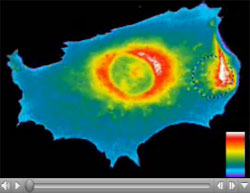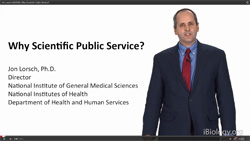We’re recruiting for a program director (also known as a health scientist administrator or program officer) to manage research grant, fellowship, training, and other types of awards focused on the structure and function of cells and cellular components, and the cellular and molecular mechanisms that underlie inheritance, gene expression, and development. The position is in our Division of Genetics and Molecular, Cellular, and Developmental Biology, and it involves working collaboratively with other program directors in the division to support outstanding science in these fields. Candidates should have expertise in state-of-the-art molecular genetics, cell biology, and/or developmental biology. Familiarity with NIH extramural funding as an applicant, reviewer, or NIH scientific administrator is a plus, and outstanding written and oral communication skills are essential. Continue reading “Wanted: Genetics, Molecular, Cellular, and Developmental Biology Program Director”
Posts by James Deatherage
CBB Division Director Catherine Lewis Retires

Catherine D. Lewis, director of the NIGMS Division of Cell Biology and Biophysics (CBB), retired in January after more than 30 years of service at the NIH. Throughout her career, Cathy was widely recognized for her scientific foresight and leadership, including the early recognition of important emerging research opportunities in molecular biology, biophysics and microscopy. Her tireless work behind the scenes ensured that these transformational new research approaches were seamlessly integrated into the NIH portfolio and able to grow rapidly.
Cathy earned an M.S. and Ph.D. in biochemistry from Princeton University and joined NIH in 1983 as a staff fellow at NIDDK in the lab of Gary Felsenfeld, where she studied chromatin structure and the regulation of beta-globin gene expression during development.
Her career at NIGMS started in 1989, when Cathy moved to the Institute as a program director in the Genetics Division—led at the time by Judith Greenberg. She managed grants on cell nuclear structure and function and was instrumental in the development of programs focused on epigenetic regulation. Eight years later, Cathy became CBB’s Biophysics Branch chief. In that role, she at one point managed nearly 400 grants, some of which led to breakthroughs such as the structure of the ribosome. She also initiated NIGMS programs focused on new single-molecule methods and nanotechnology. In 2006, Cathy took over as director of CBB. During this period, she oversaw changes in the direction of the NIGMS Protein Structure Initiative, promoted advances in high-resolution optical microscopy and cellular imaging, and led efforts to support atomic resolution cryo-electron microscopy, including a new Common Fund initiative.
During her tenure at NIH, Cathy received two NIH Director’s Awards, for her work on trans-NIH initiatives and her leadership on science education in elementary schools.
Cathy’s door was always open to all, and her advice was constantly sought by colleagues, not only in her own division, but widely across NIGMS and NIH.
Most importantly, Cathy maintained warm professional and personal relationships with those around her, while getting things done and influencing others. “Leading a division that worked well and where people respected each other and got along is something that I’m happy to have been involved in,” she says.
Working in the CBB division was fun, because she helped make it so. She will be missed.
NIH Workshop on Reproducibility in Cell Culture Studies
NIGMS is actively involved in NIH-wide efforts to enhance rigor and reproducibility in research. As part of our work on this issue, we will co-host a trans-NIH workshop on September 28-29, 2015, to examine current quality-control challenges in cell culture research and identify opportunities for expanding its capabilities and applications. The meeting will be videocast and archived on the NIH Videocasting site.
The workshop agenda includes panel discussions led by researchers from academia and industry on cell line identification, genetic and phenotypic characterization of cells, heterogeneity in populations of cells, reagents, and research and reporting standards. The meeting will also cover new approaches to understanding the characteristics and behaviors of cultured cells and technologies for enhancing their usefulness in research.
Resource Spotlight: iBiology Videos
 . He also answers questions from the scientific community
. He also answers questions from the scientific community  during an iBiology Q&A session.
during an iBiology Q&A session.One of the research and training resources we help fund is iBiology  , a collection of high-quality, free online videos of scientists talking about their research, career paths and related topics. The project, which also receives support from the National Science Foundation and other organizations, produces material that is relevant to those at a range of educational and career levels, especially undergraduate students, graduate students and postdocs.
, a collection of high-quality, free online videos of scientists talking about their research, career paths and related topics. The project, which also receives support from the National Science Foundation and other organizations, produces material that is relevant to those at a range of educational and career levels, especially undergraduate students, graduate students and postdocs.
When Ron Vale started the iBiology project in 2006, his goal was to give people around the world broader access to research seminars. Since then, the scope has expanded. The collection now includes 350 videos that fall into three main categories:
Send Input on Single-Cell Analysis
 NIH is seeking broad input from the scientific community on challenges and opportunities in single-cell analysis, a topic of great interest and relevance to many NIGMS grantees and applicants. Please help NIH shape its future programs in this emerging research area by sending in your opinions. The request for information (RFI) asks for responses on topics including:
NIH is seeking broad input from the scientific community on challenges and opportunities in single-cell analysis, a topic of great interest and relevance to many NIGMS grantees and applicants. Please help NIH shape its future programs in this emerging research area by sending in your opinions. The request for information (RFI) asks for responses on topics including:
- Current conceptual, technical and/or methodological challenges in the field;
- Major biomedical research questions that can be addressed by single-cell analysis; and
- The highest priority tools and resources needed to move forward.
We hope you’ll take the time to weigh in with your opinions and specific examples between now and the March 18 response deadline.
Let me know if you would like to learn more about trans-NIH activities in this area, as I’m a member of the group that issued this RFI—the Single Cell Analysis Working Group of the NIH Common Fund (formerly known as the NIH Roadmap), which provides strategic planning, coordination and support for programs that cut across NIH institutes and centers.


